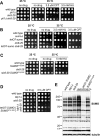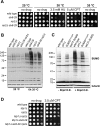SUMO-targeted ubiquitin ligase activity can either suppress or promote genome instability, depending on the nature of the DNA lesion
- PMID: 28475613
- PMCID: PMC5438191
- DOI: 10.1371/journal.pgen.1006776
SUMO-targeted ubiquitin ligase activity can either suppress or promote genome instability, depending on the nature of the DNA lesion
Abstract
The posttranslational modifiers SUMO and ubiquitin critically regulate the DNA damage response (DDR). Important crosstalk between these modifiers at DNA lesions is mediated by the SUMO-targeted ubiquitin ligase (STUbL), which ubiquitinates SUMO chains to generate SUMO-ubiquitin hybrids. These SUMO-ubiquitin hybrids attract DDR proteins able to bind both modifiers, and/or are degraded at the proteasome. Despite these insights, specific roles for SUMO chains and STUbL in the DDR remain poorly defined. Notably, fission yeast defective in SUMO chain formation exhibit near wild-type resistance to genotoxins and moreover, have a greatly reduced dependency on STUbL activity for DNA repair. Based on these and other data, we propose that a critical role of STUbL is to antagonize DDR-inhibitory SUMO chain formation at DNA lesions. In this regard, we identify a SUMO-binding Swi2/Snf2 translocase called Rrp2 (ScUls1) as a mediator of the DDR defects in STUbL mutant cells. Therefore, in support of our proposal, SUMO chains attract activities that can antagonize STUbL and other DNA repair factors. Finally, we find that Taz1TRF1/TRF2-deficiency triggers extensive telomeric poly-SUMOylation. In this setting STUbL, together with its cofactor Cdc48p97, actually promotes genomic instability caused by the aberrant processing of taz1Δ telomeres by DNA repair factors. In summary, depending on the nature of the initiating DNA lesion, STUbL activity can either be beneficial or harmful.
Conflict of interest statement
The authors have declared that no competing interests exist.
Figures








Similar articles
-
Functional Crosstalk between the PP2A and SUMO Pathways Revealed by Analysis of STUbL Suppressor, razor 1-1.PLoS Genet. 2016 Jul 11;12(7):e1006165. doi: 10.1371/journal.pgen.1006165. eCollection 2016 Jul. PLoS Genet. 2016. PMID: 27398807 Free PMC article.
-
SUMO-targeted ubiquitin ligase, Rad60, and Nse2 SUMO ligase suppress spontaneous Top1-mediated DNA damage and genome instability.PLoS Genet. 2011 Mar;7(3):e1001320. doi: 10.1371/journal.pgen.1001320. Epub 2011 Mar 3. PLoS Genet. 2011. PMID: 21408210 Free PMC article.
-
Dual recruitment of Cdc48 (p97)-Ufd1-Npl4 ubiquitin-selective segregase by small ubiquitin-like modifier protein (SUMO) and ubiquitin in SUMO-targeted ubiquitin ligase-mediated genome stability functions.J Biol Chem. 2012 Aug 24;287(35):29610-9. doi: 10.1074/jbc.M112.379768. Epub 2012 Jun 22. J Biol Chem. 2012. PMID: 22730331 Free PMC article.
-
Genome maintenance in Saccharomyces cerevisiae: the role of SUMO and SUMO-targeted ubiquitin ligases.Nucleic Acids Res. 2017 Mar 17;45(5):2242-2261. doi: 10.1093/nar/gkw1369. Nucleic Acids Res. 2017. PMID: 28115630 Free PMC article. Review.
-
The role of Schizosaccharomyces pombe SUMO ligases in genome stability.Biochem Soc Trans. 2007 Dec;35(Pt 6):1379-84. doi: 10.1042/BST0351379. Biochem Soc Trans. 2007. PMID: 18031226 Review.
Cited by
-
SUMO conjugation regulates immune signalling.Fly (Austin). 2020 Mar-Dec;14(1-4):62-79. doi: 10.1080/19336934.2020.1808402. Epub 2020 Aug 31. Fly (Austin). 2020. PMID: 32777975 Free PMC article. Review.
-
Brc1 Promotes the Focal Accumulation and SUMO Ligase Activity of Smc5-Smc6 during Replication Stress.Mol Cell Biol. 2019 Jan 3;39(2):e00271-18. doi: 10.1128/MCB.00271-18. Print 2019 Jan 15. Mol Cell Biol. 2019. PMID: 30348841 Free PMC article.
-
SUMO orchestrates multiple alternative DNA-protein crosslink repair pathways.Cell Rep. 2021 Nov 23;37(8):110034. doi: 10.1016/j.celrep.2021.110034. Cell Rep. 2021. PMID: 34818558 Free PMC article.
-
The nuclear pore primes recombination-dependent DNA synthesis at arrested forks by promoting SUMO removal.Nat Commun. 2020 Nov 6;11(1):5643. doi: 10.1038/s41467-020-19516-z. Nat Commun. 2020. PMID: 33159083 Free PMC article.
-
Solo or in Concert: SUMOylation in Pathogenic Fungi.Plant Pathol J. 2025 Apr;41(2):140-152. doi: 10.5423/PPJ.RW.11.2024.0180. Epub 2025 Apr 1. Plant Pathol J. 2025. PMID: 40211619 Free PMC article. Review.
References
-
- Kerscher O, Felberbaum R, Hochstrasser M. Modification of Proteins by Ubiquitin and Ubiquitin-Like Proteins. Annu Rev Cell Dev Biol. 2006;22:159–80. doi: 10.1146/annurev.cellbio.22.010605.093503 - DOI - PubMed
-
- Bekker-Jensen S, Mailand N. The ubiquitin- and SUMO-dependent signaling response to DNA double-strand breaks. FEBS Lett. 2011;585(18):2914–9. Epub 2011/06/15. doi: 10.1016/j.febslet.2011.05.056 - DOI - PubMed
-
- Cubenas-Potts C, Matunis MJ. SUMO: a multifaceted modifier of chromatin structure and function. Dev Cell. 2013;24(1):1–12. Epub 2013/01/19. PubMed Central PMCID: PMC3555686. doi: 10.1016/j.devcel.2012.11.020 - DOI - PMC - PubMed
-
- Flotho A, Melchior F. Sumoylation: a regulatory protein modification in health and disease. Annu Rev Biochem. 2013;82:357–85. Epub 2013/06/12. doi: 10.1146/annurev-biochem-061909-093311 - DOI - PubMed
-
- Girdwood DW, Tatham MH, Hay RT. SUMO and transcriptional regulation. Semin Cell Dev Biol. 2004;15(2):201–10. Epub 2004/06/24. - PubMed
MeSH terms
Substances
Grants and funding
LinkOut - more resources
Full Text Sources
Other Literature Sources
Molecular Biology Databases
Research Materials
Miscellaneous

